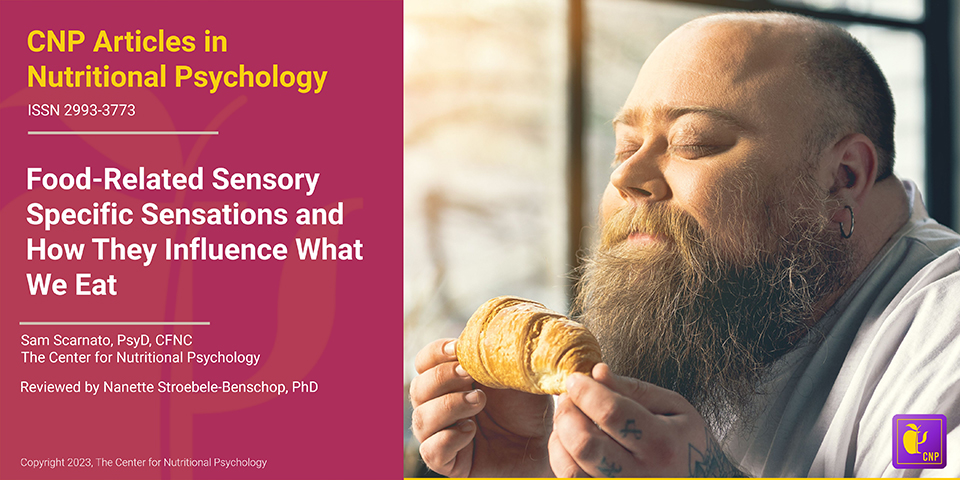Special Topic in Nutritional Psychology: Factors Contributing to Food Selection Behavior

Researchers continue to pursue a better understanding of how our food choices and eating behaviors are influenced by the subjective sensations we experience in relation to foods. In their 2020 study, Duerland and colleagues explored the relationship between subjective sensations and food choice.
In this study, 253 participants, ages 18-30 years, were recruited from a university in New Zealand. Participants were approached on campus, and the experiment occurred on site. They first answered background questions and indicated their degree of health consciousness by evaluating their level of agreement with the following statements: “I choose food carefully to ensure good health,” and “I think of myself as a health-conscious consumer.” Next, participants used a 0 (“not at all”) to 10 (“very much”) scale to rate their current experience of 13 food-related sensory-specific sensation variables: Energy, Concentration, Sleepiness, Fullness, Hunger, Overall Wellbeing, Physical Well-being, Mental Well-being, Desire-to-Eat, Desire-to-Snack, Sweet Desire, Salty Desire, and Fatty Desire (see Figure 1).

Figure 1. Thirteen food-related sensory-specific sensation variables (Duerlund, 2020)
Participants were then invited to choose a snack from six available options. The six snacks were divided into two categories, “healthy” and “unhealthy,” and encompassed sweet, salty, and fatty taste sensations. Grapes (sweet), nuts (salty), and dark chocolate (fatty) comprised the “healthy” options. “Unhealthy” snacks included jelly beans (sweet), potato chips (salty), and cookies (fatty). Participants’ snack choices were recorded.
Overall, grapes were chosen most often, and jellybeans the least. Sensory-specific sensations did impact snack-choice behavior. Sweet Desire, Salty Desire, and Fatty Desire demonstrated the greatest effects. Specifically, higher ratings of Salty Desire and Fatty Desire led to an increased likelihood of selecting potato chips. High Sweet Desire was associated with choosing dark chocolate. Other sensations found to impact snack choice included Hunger, Physical Well-Being, Desire-to Eat, and Desire-to-Snack.

Figure 2. Sensory-Specific Sensations and Snack Choice (Duerlund, 2020)
Background information also affected snack choice, which the authors explain is indicative of the multitude of factors contributing to food-selection behavior. In this study, high health consciousness and female gender drove the selection of “healthy” snacks, while the male gender was most associated with the “unhealthy” choices.
These findings provide new insights into how subjective sensations, health consciousness, and even gender can impact snack choice, which the authors note could contribute to a better understanding of public health issues, such as unhealthy snacking and obesity.
Editor’s Note:
While it is important to know more about people’s food choice behavior in relation to their sensations, several aspects should be taken into consideration when reading this study and its study design. Taste is one of the major contributors when it comes to a food choice (e.g., Diószegi et al., 2019) and could have influenced the results of this study; jellybeans are a good example for this as it is either liked or rather disliked by people compared to a more “neutral” food such as grapes. Thus, choosing food is also related to taste preference. Another aspect is the timing of the study. The study was conducted between 8 am and 4 pm which could have influenced food choice behavior since situational appropriateness impacts people’s food preferences (Cardello et al., 2000). The desire to eat jellybeans at 8 am might differ drastically from the desire to eat them at 3 pm, while this might not be the case for cookies or nuts. Both aspects could have been taken into consideration when conducting and analyzing this study. However, despite these limitations, the study provides an important contribution to the literature on the influence of sensations on food choice behavior.
References:
Cardello, A.V., Schutz, H.G., & Snow, C. (2000). Predictors of food acceptance, consumption and satisfaction in specific eating situations. Food Quality and Preferences, 11(3), 201-216. https://doi.org/10.1016/S0950-3293(99)00055-5
Duerland, M., Andersen, B.V., Alexi, N., Peng, M., & Byrne, D.V. (2020). Subjective sensations related to food as determinants of snack choice. Foods, 9(3): 336. https://doi.org/10.3390/foods9030336
Diószegi, J., Llanaj, E., & & Ádány, R. (2019). Genetic background of taste perception, taste preferences, and its nutritional implications: A systematic review. Frontiers in Genetics, 10, 1272. https://doi.org/10.3389/fgene.2019.01272








Leave a comment